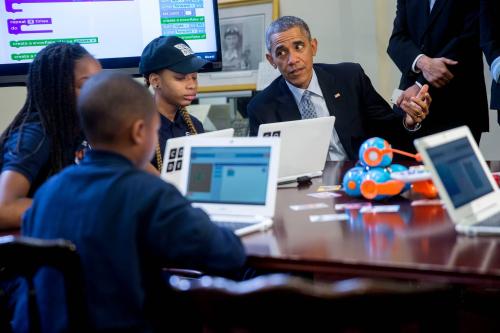In the coming months, the U.S. Department of Education will consider changes to regulations affecting which colleges can provide students with federal student grants and loans through the negotiated rulemaking process. An important consideration is whether requiring institutions (or programs within institutions) to release information on former students’ outcomes provides sufficient pressure to improve future students’ success or, alternatively, whether a school’s access to federal student aid dollars should depend on specific measures of student outcomes.
As higher education economists and policy scholars, we have come to understand a simple fact, grounded in a growing body of research: Information alone is not enough to steer students away from poorly performing schools. Pretending otherwise will only exacerbate ongoing inequities in our higher education system and in society. The federal government has the data needed to put in place an accountability system that would improve outcomes for students while also saving taxpayer dollars. Now, it needs to act.
The market for higher education is far from the textbook version of a competitive market where the forces of supply and demand might lead poor-performing institutions to shut down without government intervention. Multiple market failures make this unlikely. Among the most important, the market for higher education is characterized by imperfect information. Institutions (and, in our view, the federal government) have more information on school quality and student outcomes than the students who are considering whether and where to enroll.
This lack of information is compounded by the fact that college education is an experience good, where the full value of a product (i.e., college) may not be known until after buying it (i.e., enrolling). Students have little way of knowing how well the institution will meet their needs until after they experience it—and after they have taken on debt to attend.
The Obama administration aimed to ameliorate some of these information gaps with the College Scorecard. One of the goals of the scorecard was to help prospective students choose between institutions by making information on student outcomes—in particular, graduation rates, earnings, and debt—easy to access and digest. In 2015, the College Scorecard released information on student outcomes on a user-friendly government website for the first time. Since the rollout of the scorecard, several economists and policy scholars have studied the effects of this new information on college choices. One study found evidence that some students changed their application behavior in response to the scorecard, but importantly, these changes were concentrated among white students, Asian students, and those coming from well-resourced high schools. The authors found no significant impacts on Black and Hispanic students’ college choices. These results suggest that information provision alone is not enough to influence the choices of the students who tend to have the least information on college options. Moreover, absent other interventions, an information release alone could potentially have the unintended consequence of widening gaps in college access and attainment by race, ethnicity, and socioeconomic status.
The literature on the responsiveness of institutions to information disclosure also suggests that information disclosure alone is not enough to elicit change, as both student and institutional behavior are unresponsive to this type of information. The only institutional response appears to be strategic, as institutions seek to revise their information, rather than improve.
In the for-profit sector in particular, high advertising spending coupled with allegedly misleading claims increase the chances that students will unknowingly invest in an education that does not pay off. Although they comprise a relatively small share of the market, for-profit institutions enroll disproportionate shares of low-income students, students of color, veterans, older working students, and single parents, while typically charging higher tuition, relying more heavily on federal student aid, and generating worse student outcomes than other sectors. High student loan default rates in this sector mean there’s a real risk that, if students choose the wrong school or program, they aren’t just missing out on alternative opportunities, but could end up worse off than they were before enrollment. Moreover, choices about whether and how much to borrow can be complex and students are easily overwhelmed when presented with too many options.
The federal government not only has more information on college performance, but also has more experience in interpreting this information than does the typical college applicant. While it is not the government’s role to tell students where they should go, it has an obligation to identify, sanction, and possibly close institutions where students should definitely not go. Students may reasonably assume that federal-aid-eligible institutions must meet some minimum bar of quality, but right now the bar is set shockingly low. Schools with unacceptably poor outcomes must be held directly accountable, rather than placing the burden on vulnerable students to figure this out on their own—because students’ livelihoods are at risk if they make a mistake.
Over the last several years, a growing body of literature has made it clear that providing information is not enough to keep college students from making decisions that ultimately leave them worse off, potentially leaving them with low earnings, high debt, and no degree in hand. The literature is also clear that information disclosure alone is not sufficient to ensure student success and reduce racial, ethnic, and socioeconomic inequities in higher education.
The federal government has the authority and the tools at its disposal to ensure that institutions provide value to students. There are many ways to measure value and assess the performance of institutions, including debt-to-earnings thresholds, high school earnings comparisons, and loan repayment rates. While it may not be clear exactly how to best enforce accountability on low-performing institutions, it is abundantly clear that information on the College Scorecard alone doesn’t cut it.
This piece was authored as part of the Postsecondary Equity and Economics Research Project. We thank Bianca Onwukwe for excellent research assistance.








Commentary
Why information alone is not enough to improve higher education outcomes
December 14, 2021